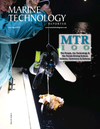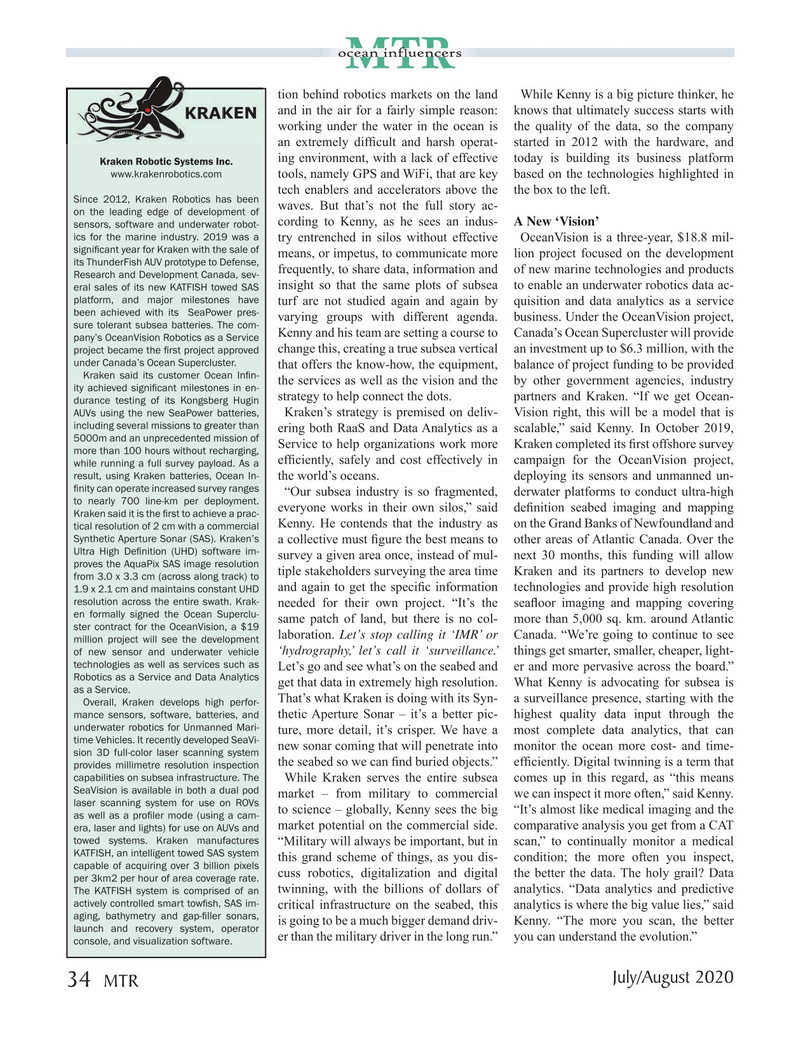
Page 34: of Marine Technology Magazine (July 2020)
Read this page in Pdf, Flash or Html5 edition of July 2020 Marine Technology Magazine
ocean inf uencersl
MTRMTR tion behind robotics markets on the land While Kenny is a big picture thinker, he and in the air for a fairly simple reason: knows that ultimately success starts with working under the water in the ocean is the quality of the data, so the company an extremely dif? cult and harsh operat- started in 2012 with the hardware, and ing environment, with a lack of effective today is building its business platform
Kraken Robotic Systems Inc.
www.krakenrobotics.com tools, namely GPS and WiFi, that are key based on the technologies highlighted in tech enablers and accelerators above the the box to the left.
Since 2012, Kraken Robotics has been waves. But that’s not the full story ac- on the leading edge of development of cording to Kenny, as he sees an indus- A New ‘Vision’ sensors, software and underwater robot- ics for the marine industry. 2019 was a try entrenched in silos without effective OceanVision is a three-year, $18.8 mil- signi? cant year for Kraken with the sale of means, or impetus, to communicate more lion project focused on the development its ThunderFish AUV prototype to Defense, frequently, to share data, information and of new marine technologies and products
Research and Development Canada, sev- insight so that the same plots of subsea to enable an underwater robotics data ac- eral sales of its new KATFISH towed SAS platform, and major milestones have turf are not studied again and again by quisition and data analytics as a service been achieved with its SeaPower pres- varying groups with different agenda. business. Under the OceanVision project, sure tolerant subsea batteries. The com-
Kenny and his team are setting a course to Canada’s Ocean Supercluster will provide pany’s OceanVision Robotics as a Service change this, creating a true subsea vertical an investment up to $6.3 million, with the project became the ? rst project approved under Canada’s Ocean Supercluster. that offers the know-how, the equipment, balance of project funding to be provided
Kraken said its customer Ocean In? n- the services as well as the vision and the by other government agencies, industry ity achieved signi? cant milestones in en- strategy to help connect the dots. partners and Kraken. “If we get Ocean- durance testing of its Kongsberg Hugin
Kraken’s strategy is premised on deliv- Vision right, this will be a model that is
AUVs using the new SeaPower batteries, including several missions to greater than ering both RaaS and Data Analytics as a scalable,” said Kenny. In October 2019, 5000m and an unprecedented mission of
Service to help organizations work more Kraken completed its ? rst offshore survey more than 100 hours without recharging, ef? ciently, safely and cost effectively in campaign for the OceanVision project, while running a full survey payload. As a result, using Kraken batteries, Ocean In- the world’s oceans. deploying its sensors and unmanned un- ? nity can operate increased survey ranges “Our subsea industry is so fragmented, derwater platforms to conduct ultra-high to nearly 700 line-km per deployment. everyone works in their own silos,” said de? nition seabed imaging and mapping
Kraken said it is the ? rst to achieve a prac-
Kenny. He contends that the industry as on the Grand Banks of Newfoundland and tical resolution of 2 cm with a commercial
Synthetic Aperture Sonar (SAS). Kraken’s a collective must ? gure the best means to other areas of Atlantic Canada. Over the
Ultra High De? nition (UHD) software im- survey a given area once, instead of mul- next 30 months, this funding will allow proves the AquaPix SAS image resolution tiple stakeholders surveying the area time Kraken and its partners to develop new from 3.0 x 3.3 cm (across along track) to and again to get the speci? c information technologies and provide high resolution 1.9 x 2.1 cm and maintains constant UHD resolution across the entire swath. Krak- needed for their own project. “It’s the sea? oor imaging and mapping covering en formally signed the Ocean Superclu- same patch of land, but there is no col- more than 5,000 sq. km. around Atlantic ster contract for the OceanVision, a $19 laboration. Let’s stop calling it ‘IMR’ or Canada. “We’re going to continue to see million project will see the development ‘hydrography,’ let’s call it ‘surveillance.’ things get smarter, smaller, cheaper, light- of new sensor and underwater vehicle technologies as well as services such as
Let’s go and see what’s on the seabed and er and more pervasive across the board.”
Robotics as a Service and Data Analytics get that data in extremely high resolution. What Kenny is advocating for subsea is as a Service.
That’s what Kraken is doing with its Syn- a surveillance presence, starting with the
Overall, Kraken develops high perfor- thetic Aperture Sonar – it’s a better pic- highest quality data input through the mance sensors, software, batteries, and underwater robotics for Unmanned Mari- ture, more detail, it’s crisper. We have a most complete data analytics, that can time Vehicles. It recently developed SeaVi- new sonar coming that will penetrate into monitor the ocean more cost- and time- sion 3D full-color laser scanning system the seabed so we can ? nd buried objects.” ef? ciently. Digital twinning is a term that provides millimetre resolution inspection capabilities on subsea infrastructure. The
While Kraken serves the entire subsea comes up in this regard, as “this means
SeaVision is available in both a dual pod market – from military to commercial we can inspect it more often,” said Kenny. laser scanning system for use on ROVs to science – globally, Kenny sees the big “It’s almost like medical imaging and the as well as a pro? ler mode (using a cam- market potential on the commercial side. comparative analysis you get from a CAT era, laser and lights) for use on AUVs and towed systems. Kraken manufactures “Military will always be important, but in scan,” to continually monitor a medical
KATFISH, an intelligent towed SAS system this grand scheme of things, as you dis- condition; the more often you inspect, capable of acquiring over 3 billion pixels cuss robotics, digitalization and digital the better the data. The holy grail? Data per 3km2 per hour of area coverage rate. twinning, with the billions of dollars of analytics. “Data analytics and predictive
The KATFISH system is comprised of an actively controlled smart tow? sh, SAS im- critical infrastructure on the seabed, this analytics is where the big value lies,” said aging, bathymetry and gap-? ller sonars, is going to be a much bigger demand driv- Kenny. “The more you scan, the better launch and recovery system, operator er than the military driver in the long run.” you can understand the evolution.” console, and visualization software.
July/August 2020 34
MTR
MTR #6 (34-49).indd 34 8/12/2020 5:20:13 PM

 33
33

 35
35
